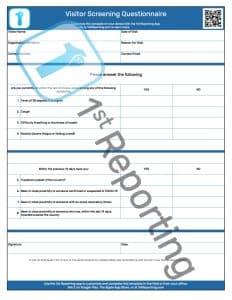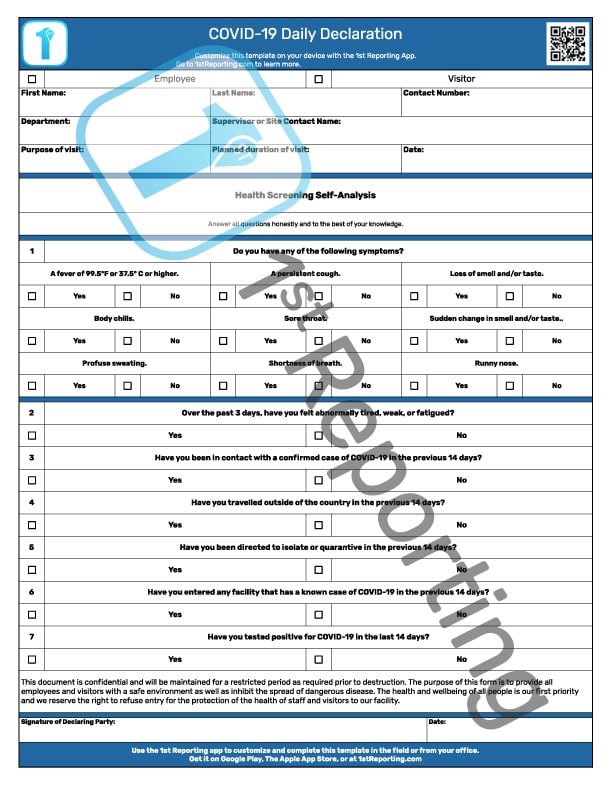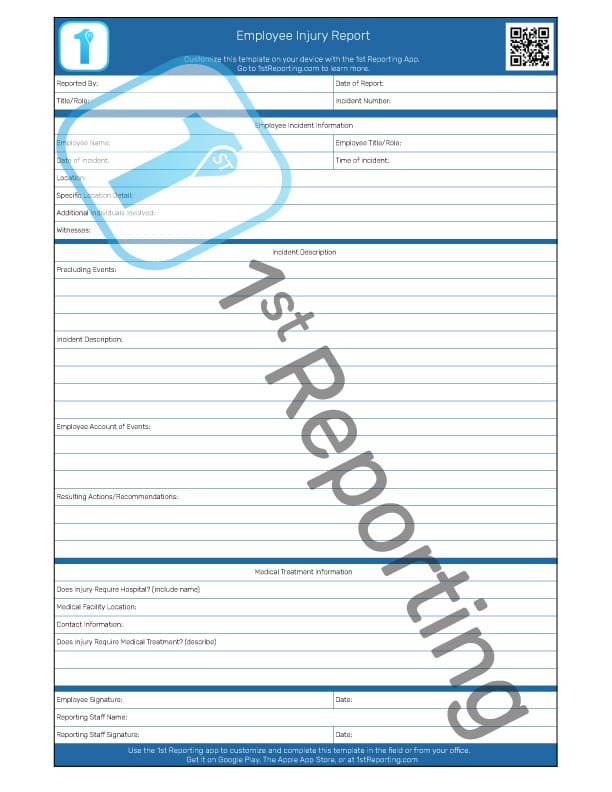
Looking for an Employee / Visitor Screening Form set to download? In extraordinary times of turmoil, we’re all reminded of the importance of due diligence. Maintaining a healthy and safe facility for your staff and visitors is essential for businesses’ continued operation, pandemic or not. And that’s why using a proper employee or visitor screening questionnaire is vital to a consistent health and safety plan.
The Employee And Visitor Screening Form requests truthful information from visitors who wish to gain entry to your facility. The form design is to sort employees and visitors by possible viral infection and exposure to facilitate maintaining a healthy and safe working environment for your business.
From December of 2019 to mid-November 2020, the coronavirus spread to over 54 million people worldwide. That’s a strong case for a robust and vigilant employee and visitor screening form policy for any business.
We’ll review what you will find included in the form, how and why to use the way, some great tips and tricks for employee and visitor screening for both office and warehouse scenarios, and some further helpful facts to get your screening policy off to a great start.
The Employee / Visitor Screening Form
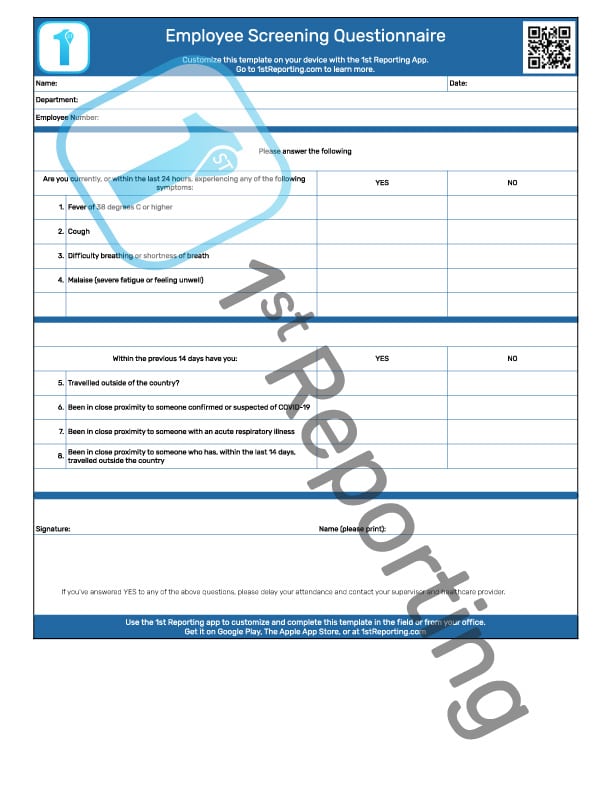
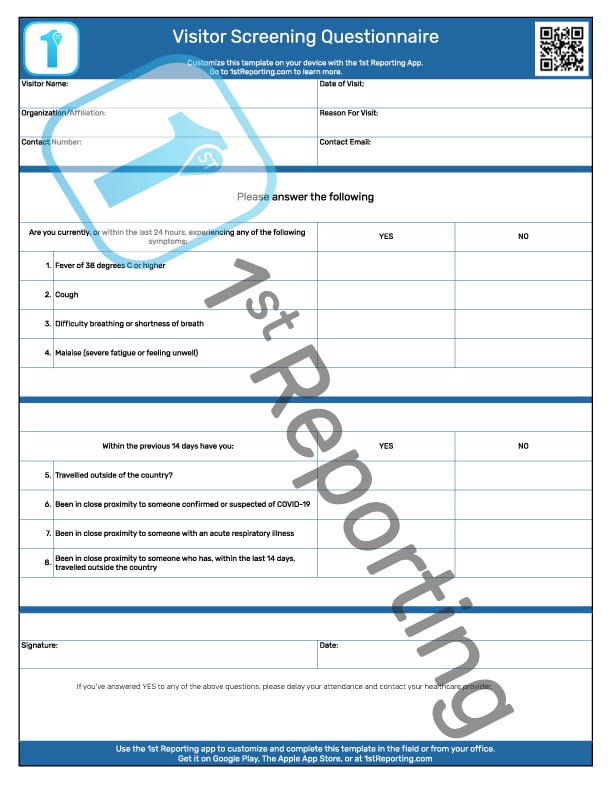
The 4 Sections Of The Employee / Visitor Screening Questionnaire
- Employee Or Visitor General Information
- Immediate Symptoms Questions
- 14-Day Period Exposure Questions
- Questionnaire Sign-Off
Employee Or Visitor General Information
The Employee or visitor general information section collects data about the individual who wishes to gain entry to the facility. It includes their name, company information, the reason for the visit, the date, and the individual’s contact information. In the case of the employee, less information is required.
Immediate Symptoms Questions
The immediate symptoms questions section of the visitor screening template fulfills the need to determine any present viral infection symptoms.
14-Day Period Exposure Questions
The 14 days is a critical exposure time reference to determine if viral exposure has occurred. These questions focus on travel to and from areas of higher exposure risk and exposure risk from proximity to others who have symptoms, test positive, or have themselves traveled to a high-risk location recently.
Questionnaire Sign-Off
The sign-off portion of the questionnaire forces the visitor to consider the honesty of the answers provided. It is human nature to ensure that anything one is singing off on is accurate to the best of their understanding. That is, one would expect and hope this to be the case, especially in a professional place of business operation.

8 Reasons Why Your Business Should Use The Employee And Visitor Screening Questionnaires
Aside from the multiple possible scenarios that might play out should a business ignore risk, several prominent and some not-so-obvious reasons to establish and maintain a robust visitor screening policy.
- Ethical Business Practice
- Community Obligations
- Responsibility To Staff
- Responsibility To Visitors
- Legal Obligations/Risk
- Maintaining Operations
- Standardized Procedures
- Industry Leadership
Ethical Business Practice
When faced with a pandemic such as a coronavirus, all businesses, governments, and individuals have an ethical obligation to their fellow humans to facilitate helping others. Active prevention of viral transmission is one such way we are all ethically obliged to do our part.
Community Obligations
A business typically has a physical location. This location also typically resides in a community. A company has an obligation to its community to do their part in maintaining a safe environment within the community.
Responsibility To Staff
As all business owners and managers are well aware, every business has a legal obligation to do their due diligence in maintaining safe working environments for their staff. Keeping infected people out of that environment is essential for a business to maintain a healthy workforce.
Responsibility To Visitors
Similar to the responsibility a business has to its employees. Likewise, a business is equally legally responsible for offering a safe place for clients, visitors, and the general public who may wish to enter the company. Maintaining a visitor screening policy helps protect healthy staff and other visitors from those who might inadvertently cause infection via exposure to a virus.
Legal Obligations/Risk
Aside from the obvious moral and ethical responsibility of a business, a company has actual legal obligations to maintain a safe working environment. It is especially true in times of significant risk to health, such as a global pandemic. Knowingly putting staff or visitors at risk or potential risk could cause a business to suffer legal ramifications, fines, or even criminal charges should the worst occur. Consult your local authorities for the most reliable source of information given a continually evolving situation.
Maintaining Operations
When operating a business with staff, managers know the importance of a good workforce. The definition of an adequate workforce for any manager includes employees who show up for work. It’s challenging to maintain a workforce if everyone is calling in sick. Therefore, a business should maintain robust visitor screening practices only for the ‘selfish’ reason for keeping operations steady. However, we all know that it’s done for the good of people’s health first, and not merely obtaining a reliable workforce.
Standardized Procedures
What will your business do when things start to return to normal? What will the new standard look like? By standardizing your screening procedures now (when it matters most), you are setting up your business as a leader for the future. Having a standard system for screening staff and visitors ensures that your company will be ready to maintain operations in the new normal once the Coronavirus pandemic has abated. And your staff returning from work-from-home settings will have the peace of mind knowing their employer is doing the right thing.
Industry Leadership
Every business wants to (or should) make a firm name for themselves within their industry. And that includes being a leader within their particular specialty. A part of leadership is making the decisions to maintain great working conditions. A business that supports excellent working conditions cultivates excellent staff. Great staff can launch a business into an industry-leading position. And that is a smart business goal, don’t you agree?

How To use The Employee Or Visitor Screening Forms
General Use Of The Screening Templates
- Employee Or Visitor General Information
The employee or visitor should complete this section in full, printed clearly, and without omissions of contact information. In the case of exposure risk, contact information is vital for tracing and warning visitors and staff if exposure potential occurred.
- Immediate Symptoms Questions
Visitors and staff ought to be encouraged to provide honest answers in their health declaration of recent symptoms. There is little this form (or any other) might accomplish for deterring those who are asymptomatic from facility entry. Still, it may ‘weed out’ those who are currently expressing symptoms of potential viral infection.
- 14-Day Period Exposure Questions
The 14-day exposure risk questions help a facility deem the level of risk and take appropriate action. Perhaps a visitor must meet an employee outside the facility using proper PPE and social distancing. Whatever the case, understanding the potential risk is the point of this section of the visitor screening template.
- Questionnaire Sign-Off
As with any declaration, there must be a ‘sign-off’ portion to transfer the information in a formal capacity. The employee or visitor is encouraged to provide honest answers when they see the form maintains a signature portion. It ought to be human nature only to sign documents that are true to the best of their understanding.
Screening Employees And Visitors In Office Settings
The visitor screening template is a form to screen the visitors coming into your business office environment. Similarly, the Employee Screening Form offers the same for staff. Office spaces may be more challenging to contain possible exposure threats than a larger, open facility like a warehouse.
Most office spaces have entry points which maintain a foyer of sorts. If possible, isolate entry points so that there is a staging area between the outside and in the office proper. Using a double set of entry doors to separate a sign-in point where visitors may fill out the visitor screening questionnaire is a smart idea. Think of this new world as requiring airlocks at each entry point. And these ‘airlocks’ are the perfect location for the visitor screening questionnaire.
Screening Employees And Visitors In Warehouse Settings
When using either the visitor screening template or employee screening template in a warehouse setting, it is best to leave the copies at a single entrance and utilize the access for all entry to the warehouse from outside. If possible, channel all exiting traffic through a different entry point. This flow allows for a buffer between staff and visitors in the warehouse and those entering and may not pass visitor screening.
Typical warehouse facilities maintain two or more entrances. Many facilities will operate utilizing shipping/receiving access. If possible, isolate this entry point to contain the possible infection from drivers coming and going and do not allow entry of drivers inside the facility itself (if possible).
The best practice for screening visitors and staff to your warehouse is to maintain a strict routine of using the downloadable visitor screening template and employee screening template at every entry point. Here’s a rundown of the suggested tips for an effective warehouse screening strategy:
- Screen every visitor and employee each time they enter the facility
- Maintain strict entry/exit points and try to streamline entry in one point and exit at another
- Secure shipping and receiving areas by isolating entry points common for drivers and other logistics personnel who may be traveling from higher exposure locations
Suggested Employee And Visitor Screening Form Protocol
- Maintain a strict policy that all visitors and staff complete a screening form in a controlled environment. It might be a foyer or between exterior and interior sets of doors.
- Maintain an open-door policy for honesty when requesting staff or visitor screening form completion. You want your employees and visitors to be honest, despite a potentially canceled meeting or another event.
- Keep all screening forms for one year. Isolate the documents and have staff only handle with gloves due to possible contagion from touch exposure. These forms should be treated like company secrets and kept stored in a secure location where they are kept strictly confidential. It ensures compliance with the Americans with Disabilities Act confidentiality rules for identifiable medical information. However, as the context is the protection of the health of staff and their families, and the fact that the staff or visitor may simply not fill out and decide to leave, means that any visitor or staff who willfully provides that information does so by their own decision and may simply refuse. It does not mean that you shouldn’t do your due diligence to maintain the utmost confidentiality.
Legal Disclaimer – This article does not constitute legal advice. Laws regarding confidentiality and medical information may be different from state to state or province to province. It is best practice to consult legal counsel to determine the full scope of your rights and obligations in your jurisdiction.
- Organizing the employee and visitor screening forms by week and month makes retrieval easier should a document be required later for inspection. Digital records are an even better solution. Take a look at the 1st Incident Reporting digital solutions if you want to up your company’s professionalism to the next level.
- Depending on local and surrounding area conditions and health statuses’, this form’s ratification may find the necessity to include possible travel locations.
Screening Tip: Why not set up a tablet or computer at each entrance? An employee or visitor screening form could be filed out right at your entrance ‘air-lock’ without the need for staff risking exposure.
Visitor and Staff Screening Requirements
Depending on your business’s nature and the industry you are involved with, there will be various distinct visitor and staff screening requirements. Each state, province, region, and country has its own rules concerning these processes. Some of the more sensitive industries include businesses and facilities relating to some of the following:
- Food Production
- Food Service
- Health Care Facilities (X-Ray Laboratories, Blood Test Facilities, Chiropractic, Dental, Eyecare et cetera)
- Hospitals and Clinics
- Long-Term Care Facilities
- Medical Manufacturing
- Pharmaceutical Manufacturing
Each of these facilities and industries will have their own set of ISO or other standards or local legal requirements for proper screening. With evolving situations like a pandemic where laws and standards can change in a matter of hours, determining a precedent for visitor and staff screening requirements to report on the subject can be difficult. For this reason, you check with local authorities for further instructions about your legal obligations for screening visitors and staff.
To shed some light on this proverbial darkness, let’s take a look at what the CDC has to say.
Best Practice: Digital Solutions
At 1st Incident Reporting, we believe that a digitally-based reporting solution is not only beneficial to business; its hand’s down the best option out there. With visitors and staff’s ability to fill out reports such as the screening report digitally, the documents may be ready the second they face completion.
Saving paper, the headache of creating a filing system, and the manual filing labor are all great reasons to look at going digital. But it isn’t just an increase in ROI by lowering your staff labor expenses that should catch your eye here. It’s the fact that you can have your staff notified at the blink of an eye to spring into action when an incident occurs – this is the real benefit of digital reporting. Incident reporting in a digital ecosystem allows your company the chance to resolve incidents before they become real problems.
Start your Free Trial today and experience incident reporting – the digital way.
CDC Guidance By Facility Type (For Healthcare Industry) – USA
| Facility Type | CDC Provided Resource |
| Alternate Care Sites | Guidance |
| Ambulatory Care Settings | Guidance |
| Assisted Living Facilities | Guidance |
| Blood and Plasma Facilities | Guidance |
| Dental Settings | Guidance |
| Dialysis Facilities | Guidance |
| Hospitals | Guidance | Preparedness |
| Nursing Homes & Long-Term-Care Facilities | Guidance | Preparedness |
| Pharmacies | Guidance |
| Relief Healthcare Facilities | Guidance |
Sources
- https://www.cdc.gov/coronavirus/2019-ncov/hcp/us-healthcare-facilities.html
- https://www.cdc.gov/coronavirus/2019-ncov/hcp/non-us-settings/hcf-visitors.html
- http://publichealth.lacounty.gov/acd/docs/VisitorsGuidance.pdf
- https://www.azdhs.gov/documents/licensing/residential-facilities/visitor-screening-protocol.pdf
- https://www.health.state.mn.us/diseases/coronavirus/facilityhlthscreen.pdf
- https://www.bakermckenzie.com/en/insight/publications/2020/03/employer-and-visitor-screenings-a-privacy
- https://leginfo.legislature.ca.gov/faces/codes_displaySection.xhtml?sectionNum=56.10.&lawCode=CIV
- https://statutes.capitol.texas.gov/Docs/HS/htm/HS.181.htm
- https://www.who.int/news/item/27-04-2020-who-timeline—covid-19
